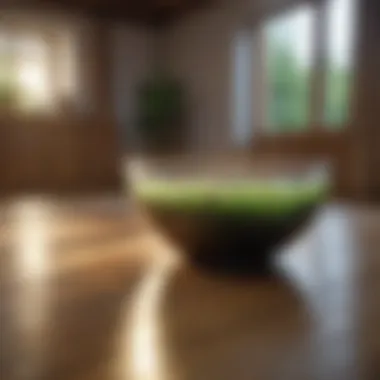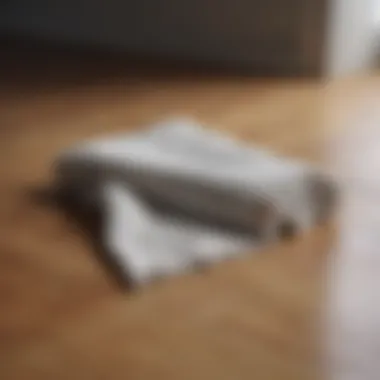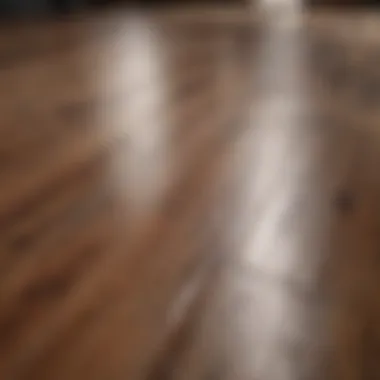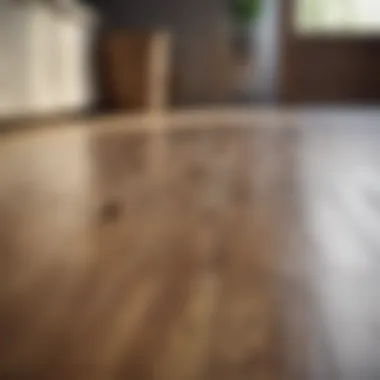Natural Ways to Clean Your Wooden Floors Effectively


Intro
The emphasis here is on environmentally friendly solutions, making it essential for those who prioritize sustainability in their home care practices. Additionally, proper cleaning methods can enhance the visual appeal of wooden floors, leading to a more inviting and comfortable environment.
Understanding Wooden Floors
Wooden floors are more than just a choice of material; they are an investment in a home’s aesthetic and overall value. Understanding wooden floors involves knowing not only the various types available but also the characteristics that make them suitable for different environments. This section will explore these important aspects that help readers appreciate their wooden flooring choices better.
Types of Wooden Flooring
When it comes to wooden flooring, there are several types that one can consider. Each type has its unique qualities and is suitable for different settings. Here are the common categories:
- Solid Hardwood: This is cut from a single piece of timber. It is durable and can be sanded or refinished multiple times. Species like oak, maple, and cherry are popular choices for solid hardwood floors.
- Engineered Wood: Made of several layers of wood, engineered wood provides additional stability. It can resist humidity and temperature changes better than solid hardwood. This option is great for basements or homes in areas with fluctuating climates.
- Bamboo: Technically a grass, bamboo flooring is rapidly renewable and environmentally friendly. It has a unique look and can be more resistant to scratches than traditional hardwoods.
- Laminate: Although not real wood, laminate flooring simulates the appearance of wood. It is made from a composite base and a photographic layer to give it a wooden look. It is durable and cost-effective but lacks the elegance of real wood.
Each type has pros and cons and suitability depends on personal preferences and specific use cases.
Benefits of Natural Cleaning Methods
Natural cleaning methods offer several benefits that align with an environmentally conscious way of living. Using ingredients like vinegar, baking soda, and Castile soap for cleaning wooden floors can enhance both appearance and durability. Here’s why natural methods stand out:
- Non-Toxic: Natural cleaning agents do not contain harmful chemicals that can affect indoor air quality. This is especially important for homes with children or pets.
- Eco-Friendly: By using sustainable materials, you reduce the environmental impact. Cleaning naturally is a step towards being more responsible in home maintenance.
- Cost-Effective: Many natural cleaning solutions are commonly found in most households. This can lead to significant savings on commercial cleaning products.
- Gentle on Floors: Natural solutions are less abrasive compared to commercial cleaners. They help prevent damage to the finish of the wooden floor, maintaining its shine and integrity over time.
Utilizing natural cleaning methods ensures the longevity of your wooden floors and contributes to a healthier living space.
Essential Cleaning Supplies
Cleaning wooden floors requires thoughtful selection of supplies. Using the right tools can enhance the effectiveness of natural cleaning methods. Supplies not only help in deep cleaning but also protect the wood from damage. This section emphasizes different categories of supplies essential for natural wooden floor cleaning.
Natural Cleaning Solutions
Natural cleaning solutions are vital for maintaining the beauty of wooden floors without harming the environment or the finish. Here are three common options:
Vinegar
Vinegar serves as a versatile cleaning agent. It is acidic in nature, which helps to break down dirt and grime on wooden surfaces. A key characteristic of vinegar is that it is non-toxic, making it a safe choice for homes with pets and children. Its unique feature is its ability to disinfect and eliminate odors without leaving harmful residues. However, it is important to use it in moderation, as excessive use can dull the floor's finish.
Baking Soda
Baking soda is another effective and natural cleaning option. Known for its gentle abrasive properties, it can effectively lift stains and grime without scratching the wood. Its affordability and availability make it a popular choice for any cleaning regimen. This substance can neutralize odors and is especially useful for tougher stains when made into a paste. A disadvantage, however, is that it may require more effort to scrub stubborn stains compared to commercial cleaners.
Castile Soap
Castile Soap is a plant-based soap that emerges as a premium cleaner for wooden floors. The main advantage of Castile Soap is its biodegradable nature. It is gentle yet effective for cleaning, not compromising the floor’s finish. Moreover, it does not contain synthetic chemicals, which is another appealing aspect for environmentally conscious individuals. One downside could be the potential for leaving a slight residue if not rinsed properly, so it is essential to follow up with a clean damp mop.


Additional Materials Needed
Apart from natural cleaning solutions, certain tools are essential to maximize the cleaning process. These tools can make the job easier and more effective.
Mop
The mop is essential for cleaning wooden floors. A good mop is effective in distributing the cleaning solution evenly across the surface. It should ideally have a microfiber head that can trap dirt effectively. A significant advantage of using a mop with a removable head is that it can be washed and reused, making it a cost-effective option in the long run. However, using too much water while mopping can lead to water damage, so care should be taken in its usage.
Broom
A broom remains a classic tool for clearing dust and debris from wooden floors. A key characteristic is its versatility; it can reach corners where vacuums may struggle. It is especially beneficial for maintaining cleanliness before a deep cleaning session. A unique feature is that it offers a silent cleaning method, unlike vacuuming, which may irritate some. However, it does have limitations for fine dust, which might require a secondary clean-up tool.
Microfiber Cloths
Microfiber cloths play a crucial role in post-cleaning maintenance. These cloths are excellent for capturing dust and dirt without the need for chemical cleaners. Their structure allows for effective cleaning without scratching the wood. A major advantage is their reusability; simply wash and dry to use again. However, users must ensure to launder them properly because residues from fabric softeners can diminish their cleaning ability.
Proper tools and natural solutions elevate the cleaning process and contribute to the longevity of your wooden floors.
Preparing for Cleaning
Preparing for the cleaning process of wooden floors is essential. It not only sets the stage for effective cleaning but can also help ensure that you do not inadvertently damage the flooring. Here are some key considerations to keep in mind before diving into the cleaning process.
First, removing loose dirt and debris is crucial. Dust and dirt can act like sandpaper on wooden surfaces, leading to scratches over time. Ensuring your floors are clear of these particles will help maintain their sheen and integrity. This step can save you from needing to repair or refinish the floors prematurely.
Next, assessing the condition of your wooden floors is important. Different finishes or types of wood may require different care methods. Understanding the specific needs of your flooring helps in choosing the right cleaning solutions. Are there any scratches? Does the finish seem dull? Such issues can determine what type of cleaning solutions will be most effective.
Moreover, planning your cleaning method in advance can lead to a more organized and efficient process. Knowing what materials and techniques you will use can streamline the task, making it less daunting. An effective cleaning regime will enhance the lifespan of your wooden floors while keeping them looking pristine.
Dusting and Sweeping
Dusting and sweeping are foundational tasks in the preparation process. Before applying any cleaning solution, it's essential to remove any loose debris. The simple act of dusting can significantly reduce the overall dirt and grime on your floors. Using a microfiber cloth or a dust mop is recommended, as these tools are effective in trapping fine dust particles rather than just moving them around.
After dusting, sweeping becomes the next key step. It is advisable to use a soft-bristle broom. This kind of broom is less likely to cause any scratches, ensuring that your wooden surfaces remain safe from damage. When sweeping, take your time to ensure you cover all edges and corners. Oftentimes, debris gathers in these areas and leads to unwanted build-up.
In addition to a broom, consider using a vacuum. However, make sure the vacuum is suitable for wooden floors. A vacuum designed for carpets can cause harm to wooden flooring. Use a vacuum without a beater bar to avoid scratching the surface. Regularly dusting and sweeping can help in keeping your wooden floors in optimal condition.
Assessing Floor Condition
Assessing the condition of your floor is a critical component of effective cleaning. Before starting, look closely at the entire surface. Check for scratches, stains, or areas where the finish seems worn. This includes examining corners and areas behind furniture, which are commonly neglected.
Understanding the type of finish on your wooden floors is vital. Different finishes like polyurethane, oil, or wax have specific care requirements. Once you know the finish type, you can choose the correct cleaning method and products accordingly. For example, vinegar solutions may work well for certain finishes, while they could potentially damage others.
Additionally, consider how long it has been since the last cleaning. If the floors feel sticky or look dull, this may indicate that a deeper clean is necessary. Minor scratches might just need gentle buffing, while severe wear might require refinishing.
Finally, addressing issues early on can prevent them from becoming more significant problems. If stains are present, tackle them promptly to avoid setting in. Keeping track of your floor's condition and addressing it regularly can prolong its lifespan.


"Regular maintenance and thorough assessments can add years to the beauty and functionality of wooden floors."
Methods for Natural Cleaning
Natural cleaning methods for wooden floors are essential for maintaining their aesthetic and structural integrity. They ensure that no harmful chemicals are introduced into the home environment, which is particularly relevant for those with allergies or young children. The importance of using eco-friendly techniques goes beyond mere cleanliness; it embodies a commitment to sustainability and health. By opting for methods like mopping with vinegar or treating spots with baking soda, you engage in practices that not only protect the wood but also contribute to a healthier indoor atmosphere.
Mopping Techniques
Using Vinegar Solution
Using a vinegar solution is a well-regarded method for natural floor cleaning. It is effective in cutting through grime and providing a streak-free finish. Vinegar's acidity aids in dissolving dirt while being gentle enough not to damage the wood’s finish. This method is popular in this article due to its accessibility and low cost.
The unique feature of vinegar is that it acts as a deodorizer as well, eliminating musty odors while refreshing the environment. However, caution is needed. Excessive vinegar can lead to dulling of finishes over time. Thus, it should be used judiciously and rinsed afterward to avoid residue.
Baking Soda Paste
Baking soda paste is another excellent option for natural cleaning. This method harnesses the abrasive nature of baking soda to lift tough stains without scratching the wood surface. Mixed with a bit of water, it serves as a gentle scrub for the tough spots that regular cleaning may miss.
Baking soda is a versatile material that absorbs odors, making it a dual-purpose cleaner. What sets it apart is that it does not leave harsh chemicals on the surface. Yet, it is essential to rinse it off completely, as leftover residue can attract dirt. Its ease of use and effectiveness make it a beneficial choice in this article.
Spot Cleaning Stains
Addressing Scuff Marks
Addressing scuff marks is a key cleaning technique that ensures the floor retains its beautiful appearance. Scuff marks can occur from furniture or shoes, detracting from the overall look of wooden floors. Using a clean, dry eraser or even a bit of the vinegar solution helps in lifting these marks without the need for heavy-duty cleaners.
The characteristic of this method lies in its simplicity; it requires few materials and minimal effort. Its effectiveness encourages regular maintenance, which is crucial for extending the life of your floor. However, for persistent marks, repeated applications may be necessary.
Treating Food Spills
Treating food spills immediately prevents long-term staining and damage. Food stains can be unsightly and difficult to remove if they are allowed to set in. A simple solution of warm water with a dash of vinegar can effectively loosen and lift stains without harming the wooden finish.
The key benefit of this approach is its proactive nature; by acting quickly, you minimize the time a spill sits on the floor. It’s an easy strategy that can significantly improve the cleanliness and appearance of wooden floors. The downside lies in the necessity for quick action, as delays can lead to tougher stains that are harder to rectify with natural methods.
Post-Cleaning Care
Post-cleaning care is a crucial step in maintaining the aesthetic and durability of wooden floors. The benefits of proper care extend beyond just appearance. When handled correctly, your wooden floors can not only look their best but also last longer. Even after the cleaning process is complete, attention must be given to drying, maintaining finish, and regular upkeep.
Drying and Maintaining Finish
After completing the cleaning process, ensuring that the wooden floors dry thoroughly is essential. Excess moisture can lead to warping or even mold growth. Here are some key points on drying and maintaining a good finish:
- Immediate Drying: After mopping, use microfiber cloths to absorb any residual moisture. This will speed up drying time and protect the wood.
- Natural Airflow: Open windows or turn on fans to enhance airflow. This method helps the floor dry evenly and quickly, preventing moisture-related issues.
- Finish Maintenance: Regularly check the finish of the wood. Maintaining it can involve applying products designed specifically for wooden floors. These can enhance shine and protect against scratches.
Regular Maintenance Tips


Wooden floors require ongoing maintenance to retain both beauty and functionality. Here are some effective tips:
- Frequent Sweeping: Regular sweeping minimizes dust and debris accumulation. This practice prevents scratches that can arise from trapped dirt.
- Use Appropriate Products: When cleaning, always choose natural products. For example, using Castile soap can help maintain the floor's integrity while providing a clean surface.
- Avoid Excess Water: Never rinse wooden floors heavily. Excess water can seep into seams and cause damage. Always limit moisture exposure.
- Protect High Traffic Areas: Consider placing rugs or mats in areas with high traffic. This will protect the floor from premature wear and tear.
"Regular upkeep transforms your wooden floors from ordinary to extraordinary, reinforcing their natural beauty and longevity."
Emphasizing post-cleaning care ensures that the benefits of natural cleaning methods are fully realized. With proper attention to drying and ongoing maintenance, you can significantly enhance the lifespan and appearance of your wooden floors.
Challenges in Cleaning Wooden Floors
Cleaning wooden floors comes with its own set of challenges that every homeowner should be aware of. Understanding these challenges is crucial for maintaining the aesthetic appeal and longevity of your floors. The delicate nature of wood requires careful attention to cleaning methods to avoid damage. Using the right approach not only preserves the beauty of your flooring but also prevents costly repairs or replacements in the future.
Water Damage Risks
Water is one of the biggest enemies of wooden flooring. Excessive moisture can lead to warping, swelling, and even the growth of mold. This risk is magnified in areas prone to spills or humidity, such as kitchens or bathrooms.
To mitigate water damage risks, it is essential to:
- Use damp mops instead of soaking wet ones. This reduces the amount of water directly contacting the wood surface.
- Wipe up spills immediately. Quick action can prevent liquid from seeping into wood seams and causing damage.
- Ensure proper ventilation. Good air circulation helps keep humidity levels low, especially in damp conditions.
Maintaining a consistent cleaning schedule is beneficial. Regular dusting can help reduce the accumulation of dirt and debris, which can trap moisture against the floor. The integration of a dehumidifier in prone areas may also help combat excessive moisture, further protecting your wooden floors.
"Understanding water damage risks is vital for anyone seeking to maintain the integrity of wooden flooring."
Dealing with Pet Stains
Pet stains present another significant challenge for wooden floor maintenance. Pets can unintentionally cause damage through accidents, leaving behind not only stains but also odors that can seep into the floor. Addressing these stains promptly is essential for preventing long-term damage and unpleasant smells.
Here are some actionable steps for effectively dealing with pet stains:
- Clean up promptly. Whenever an accident occurs, it is best to clean it immediately to minimize staining.
- Use natural cleaning solutions. A simple mixture of vinegar and water can help lift stains without damaging the wood.
- Test any cleaning solution in a small, inconspicuous area first to ensure it does not adversely affect the finish of the wood.
Additionally, consider investing in a protective sealant that makes it easier to clean future stains. Regularly vacuuming or sweeping can reduce the chances of dirt and debris becoming embedded in wooden floors, ultimately prolonging their lifespan.
Recognizing and addressing these challenges allows homeowners to maintain their wooden floors naturaly while ensuring that they remain in optimal condition.
Culmination
In this article, we explored several important aspects of cleaning wooden floors using natural methods. The significance of natural cleaning is evident not only in its effectiveness but also in its safety for both your family and the environment. Consumers today are increasingly aware of the potential harm that chemical cleaners can cause, including health risks and environmental pollution. By utilizing natural solutions, you ensure a cleaner home without compromising safety or quality.
Final Thoughts on Natural Cleaning
To wrap up, embracing natural cleaning methods for wooden floors comes with various benefits. For instance, natural products such as vinegar and baking soda are not only effective but also inexpensive and readily available. Many individuals may consider these solutions to be too simple, yet their efficacy speaks volumes. A key consideration here is the impact on well-being; avoiding harsh chemicals leads to a healthier living space.
Moreover, regular maintenance using these natural techniques helps preserve the beauty of wooden floors, ensuring they last for years. Addressing challenges promptly—such as water damage or pet stains—thanks to natural strategies, can further enhance the longevity of your flooring.
Overall, this comprehensive guide demonstrates that caring for wooden floors does not require a plethora of commercial products. Instead, leveraging natural methods allows you to maintain their elegance while being conscious of the world around you.
"Simple, natural solutions can yield exceptional results in floor care."
This approach caters to homeowners, interior design enthusiasts, and anyone keen on maintaining their living environment with integrity and care. By integrating these methods, you can achieve clean and beautiful wooden floors without unnecessary complications.







